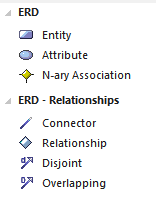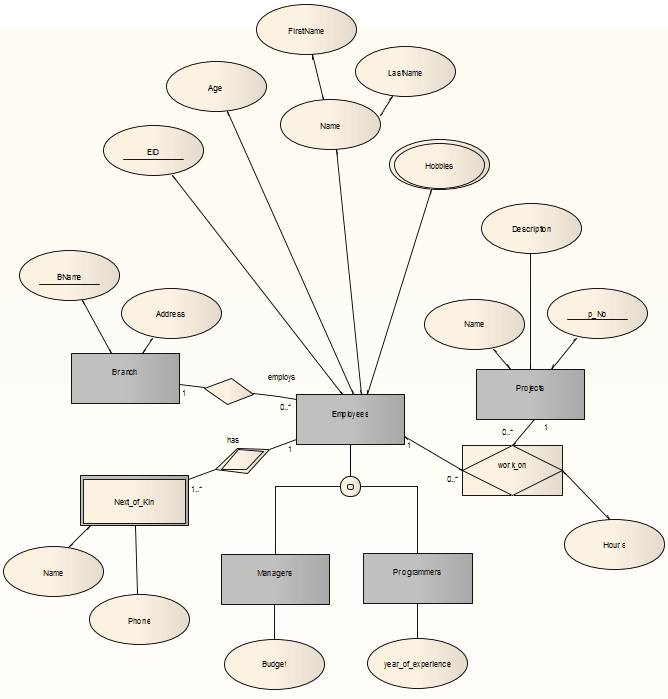| Prev | Next |
Entity Relationship Diagrams (ERDs)
According to the online Wikipedia:
An entity-relationship model (ERM) is an abstract and conceptual representation of data. Entity-relationship modeling is a database modeling method, used to produce a type of conceptual schema or semantic data model of a system, often a relational database, and its requirements in a top-down fashion. Diagrams created by this process are called Entity-Relationship Diagrams, ER Diagrams, or ERDs.
Entity Relationship Diagrams in Enterprise Architect
Entity Relationship diagrams in Enterprise Architect are based on Chen's ERD building blocks: entities (tables) are represented as rectangles, attributes (columns) are represented as ellipses (joined to their entity) and relationships between the entities are represented as diamond-shape connectors.

ERD technology in Enterprise Architect assists you in every stage from building conceptual data models to generating Data Definition Language (DDL) for the target DBMS.
MDG Technology for ERD and ERD Transformations
Enterprise Architect enables you to develop Entity Relationship diagrams quickly and simply, through use of an MDG Technology integrated with the Enterprise Architect installer.
The Entity Relationship diagram facilities are provided in the form of:
- An Entity Relationship diagram type, accessed through the 'New Diagram' dialog
- An Entity Relationship Diagram page in the Diagram Toolbox
- Entity Relationship element and relationship entries in the 'Toolbox Shortcut' menu and Quick Linker
Enterprise Architect also provides transformation templates to transform Entity Relationship diagrams into Data Modeling diagrams, and vice versa.
Entity Relationship Diagram Toolbox Page
You can access the 'Entity Relationship Diagram' page of the Diagram Toolbox by specifying 'Entity Relationship Diagrams' in the Toolbox 'Find Toolbox Item' dialog

- Entity is an object or concept that is uniquely identifiable; the property of 'Multiplicity' in the SourceRole and TargetRole definitions for the Relationship connector can be used to define the cardinality of an Entity that participates in this relationship
- Attribute is a property of an entity or a relationship type
- N-ary Association represents unary (many-to-many recursive) or ternary relationships and can also be used to represent relationships that have attributes among the entities; the N-ary Association element should always be at the target end of a connector
- Connector is a connector between an Entity and an Attribute, and between two Attributes
- Relationship is a diamond-shape connector, representing the meaningful association among entities
- Disjoint and Overlapping represent the relationships between the super-class Entity and the sub-class Entity
A typical Entity Relationship diagram

Disable Entity Relationship Diagrams
If you prefer not to use Entity Relationship diagrams in Enterprise Architect, you can disable it (and subsequently re-enable it) using the 'MDG Technologies' dialog (select the 'Specialize > Technologies > Manage' ribbon option).
Tagged Values
Some of the Entity Relationship diagram components can be modified by Tagged Values, as indicated:
Component |
Tagged Value / Notes |
|---|---|
|
Entity |
isWeakEntity Notes: If true, this entity is a weak entity. |
|
Attribute |
attributeType Notes: There are four valid options: 'normal', 'primary key', 'multi-valued' and 'derived' |
|
Attribute |
commonDataType Notes: Defines the common data type for each attribute. |
|
Attribute |
dbmsDataType Notes: Defines the customized DBMS data type for each attribute. This option is only available when the commonDataType tag is set to 'na'. You must define the customized type first through the 'Configure > Reference Data > Settings > Database Datatypes' ribbon option. |
|
N-ary Association |
isRecursive Notes: If true, the N-ary Association represents the many-to-many recursive relationship. For one-to-many and one-to-one recursive relationships, we suggest using the normal Relationship connector. Sometimes you might want to limit the stretch of the diamond-shape Relationship connectors; simply pick a Relationship connector, right-click to display the context menu, and select the 'Bend Line at Cursor' option. |
|
Relationship |
isWeak Notes: If true, the Relationship is a weak relationship. |
|
Disjoin
|
Participation Notes: There are two valid options, 'partial' and 'total'. |
Notes
Learn more

